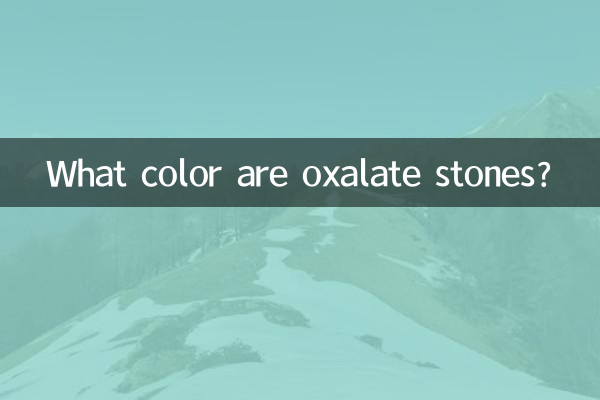What color are oxalate stones?
Oxalate stones are a common type of urinary stone that differ in color and characteristics from other types of stones. This article will introduce in detail the color, causes, symptoms and preventive measures of oxalate stones, and combine it with structured data to help readers better understand.
1. Color of oxalate stones

Oxalate stones usually appear dark brown or black, have a rough surface and are hard in texture. Since its main component is calcium oxalate, it is clearly visible under X-rays. Here's how the color of oxalate stones compares to other common stones:
| Stone type | Main ingredients | color | texture |
|---|---|---|---|
| oxalate stones | Calcium oxalate | dark brown/black | hard, rough |
| Phosphate stones | calcium phosphate | off-white | Soft and brittle |
| uric acid stones | uric acid | yellow/reddish brown | Smooth, softer |
| cystine stones | cystine | light yellow | waxy texture |
2. Causes of oxalate stones
The formation of oxalate stones is closely related to factors such as dietary habits and metabolic abnormalities. The following are the main causes:
3. Symptoms of oxalate stones
Symptoms of oxalate stones are similar to other urinary tract stones and include:
4. Preventive measures for oxalate stones
The key to preventing oxalate stones is to adjust your diet and lifestyle habits:
| Precautions | Specific methods |
|---|---|
| Increase water intake | Drink 2-3 liters of water every day to keep urine dilute. |
| Control oxalate intake | Reduce high oxalate foods such as spinach, nuts, and chocolate. |
| Appropriate amount of calcium supplement | The combination of calcium and oxalic acid can reduce absorption. It is recommended to consume 800-1200mg of calcium daily. |
| Reduce salt intake | A high-salt diet increases urinary calcium excretion and promotes stone formation. |
| Regular physical examination | Monitor oxalate and calcium levels with urine tests. |
5. Summary
Oxalate stones are usually dark brown or black in color, hard in texture, and have a rough surface. Its formation is closely related to high oxalate diet, dehydration and other factors. Preventive measures include increasing drinking water, controlling oxalic acid intake and appropriate calcium supplementation. If relevant symptoms occur, it is recommended to seek medical treatment in time to avoid complications.
Through structured data and detailed analysis, this article hopes to help readers better understand the characteristics and prevention methods of oxalate stones, and reduce the risk of stone recurrence.

check the details

check the details